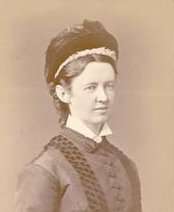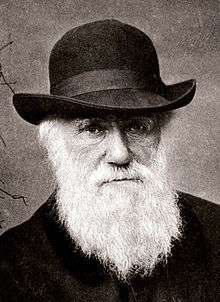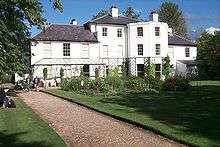Elizabeth Cotton, Lady Hope

Elizabeth Reid Cotton,[1] Lady Hope (9 December 1842 – 8 March 1922) was a British evangelist active in the Temperance movement. In 1915, she claimed to have visited the British naturalist Charles Darwin shortly before his death in 1882, during which interview Hope said Darwin spoke of second thoughts about publicising his theory of natural selection. That Hope visited Darwin is possibly true, though denied by Darwin's family, but her interpretation of what Darwin said at the putative interview is much less likely.[2]
Biography
Elizabeth Cotton was born in 1842 in Tasmania, Australia, the daughter of British irrigation engineer, General Sir Arthur Cotton, and spent her childhood in Madras, India, while her father supervised water management and canal projects in Andhra Pradesh. Her mother was Elizabeth Learmonth, the daughter of Thomas Learmonth, an Australian landowner who could trace his ancestry back to Thomas-the-Rhymer of Ercildoune.[3] Returning to England on her father's retirement in 1861, the family resided in Hadley Green and came under the influence of the Rev. William Pennefather, an evangelical Anglican clergyman. Cotton also met many contemporary evangelicals during a three-year stay in Ireland.[4]
In 1869 the family settled in Dorking, Surrey—about 12 miles from Downe, home of Charles Darwin—where Elizabeth began evangelistic and philanthropic work, first organising a Sunday school and then a "Coffee-Room," where food and non-alcoholic drinks were served. (She advocated total abstinence.[5]) Cotton held Bible classes and prayer meetings in the hall, and spoke at a Sunday evening service. A contemporary reported that she had "a pleasing, engaging manner and silvery voice, and her message was simple."[6] In 1874–75, Cotton assisted in the evangelistic meetings held by American evangelists Dwight L. Moody and Ira Sankey, counselling women converts.[7]
In 1877, at the age of 35, she married a widower, retired Admiral Sir James Hope, an evangelical and temperance advocate who was 34 years her senior. Cotton therefore became Lady Hope of Carriden. Sir James died four years later.
Thereafter Lady Hope opened several additional coffee houses and settled in London where she became involved in the work of the Golden Bells Mission in Notting Hill Gate. [8] She was a prolific author, writing more than thirty books "which dealt with evangelistic and temperance themes," many containing "personal anecdotes reminiscent of the Darwin story."[9]
In 1893, she married T. A. Denny, an evangelical Irish businessman, 24 years her senior—though she continued to use the name "Lady Hope." She and Denny opened hostels for working men and provided accommodation for soldiers returned from the Boer War. Her father died in 1899, after which she published a biography.[10] In 1903 she opened her largest temperance hostel, the Connaught Club in Marble Arch, which offered accommodation for several hundred men.[11] After Denny died in 1909, Hope befriended an ex-convict, and when she entrusted her finances to him, he took advantage of her trust. In 1911 she was declared bankrupt.[12]
In 1915, 33 years after Darwin's death and shortly after she was diagnosed with breast cancer, Hope attended a Bible conference in Northfield, Massachusetts, where she apparently first told her story about meeting Darwin. In 1922, Hope died in Sydney, where she is buried.
Lady Hope's story of her meeting with Charles Darwin


Lady Hope's story first appeared in an American Baptist newspaper, the Watchman-Examiner, on 15 August 1915, the story preceded by a four-page report on the summer Bible conference held in Northfield, which that year ran from 30 July to 15 August 1915.[13]
Original text
- It was one of those glorious autumn afternoons, that we sometimes enjoy in England, when I was asked to go in and sit with the well known professor, Charles Darwin. He was almost bedridden for some months before he died. I used to feel when I saw him that his fine presence would make a grand picture for our Royal Academy; but never did I think so more strongly than on this particular occasion.
- He was sitting up in bed, wearing a soft embroidered dressing gown, of rather a rich purple shade.
- Propped up by pillows, he was gazing out on a far-stretching scene of woods and cornfields, which glowed in the light of one of those marvelous sunsets which are the beauty of Kent and Surrey. His noble forehead and fine features seem to be lit up with pleasure as I entered the room.
- He waved his hand toward the window as he pointed out the scene beyond, while in the other hand he held an open Bible, which he was always studying.
- "What are you reading now?" I asked as I seated myself beside his bedside. "Hebrews!" he answered – "still Hebrews. 'The Royal Book' I call it. Isn't it grand?"
- Then, placing his finger on certain passages, he commented on them.
- I made some allusions to the strong opinions expressed by many persons on the history of the creation, its grandeur, and then their treatment of the earlier chapters of the Book of Genesis.
- He seemed greatly distressed, his fingers twitched nervously, and a look of agony came over his face as he said: "I was a young man with unformed ideas. I threw out queries, suggestions, wondering all the time over everything, and to my astonishment, the ideas took like wildfire. People made a religion of them."
- Then he paused, and after a few more sentences on "the holiness of God" and the "grandeur of this book," looking at the Bible which he was holding tenderly all the time, he suddenly said: "I have a summer house in the garden which holds about thirty people. It is over there," pointing through the open window. "I want you very much to speak there. I know you read the Bible in the villages. To-morrow afternoon I should like the servants on the place, some tenants and a few of the neighbours; to gather there. Will you speak to them?"
- "What shall I speak about?" I asked.
- "Christ Jesus!" he replied in a clear, emphatic voice, adding in a lower tone, "and his salvation. Is not that the best theme? And then I want you to sing some hymns with them. You lead on your small instrument, do you not?" The wonderful look of brightness and animation on his face as he said this I shall never forget, for he added: "If you take the meeting at three o'clock this window will be open, and you will know that I am joining in with the singing."
- How I wished I could have made a picture of the fine old man and his beautiful surroundings on that memorable day!
Rebuttal by Darwin's children
Everyone in Darwin's family denied the validity of the story.[14] In 1918, Darwin's son Francis wrote that "Lady Hope's account of my father's views on religion is quite untrue. I have publicly accused her of falsehood, but have not seen any reply. My father's agnostic point of view is given in my Life and Letters of Charles Darwin, Vol. I., pp. 304–317. You are at liberty to publish the above statement. Indeed, I shall be glad if you will do so." In 1922, Darwin's daughter, Henrietta Litchfield, said she did not believe Lady Hope had ever seen her father and that "he never recanted any of his scientific views, either then or earlier. We think the story of his conversion was fabricated in the U.S.A."[15] Leonard, Darwin's last surviving child, dismissed Lady Hope's account as a "hallucination" (1930) and "purely fictitious" (1934).[16]
Subsequent retellings and investigations
Lady Hope gave the fullest account of her story in a letter written (circa 1919–20) to S. James Bole, who first published it in 1940.[17] The story became a popular legend, and Hope's claims were republished as late as October 1955 in the Reformation Review and in the Monthly Record of the Free Church of Scotland in February 1957.
In 1925, J. W. C. Fegan, an evangelist and sometime associate of Lady Hope, commented on her character to one S. J. Pratt, who was investigating the story. Fegan said that although Darwin had certainly been an agnostic, he was also "an honourable, courteous, benevolent gentleman." In contrast, Fegan noted that after Hope had been "adjudicated bankrupt," she had asked him for "a commendatory letter to take with her to America, and it was my painful duty to tell her that I did not feel I could do so."[18]
In 1994 Open University lecturer and biographer James Moore published The Darwin Legend, in which he suggested that Hope had visited Darwin sometime between 28 September and 2 October 1881, when Francis and Henrietta were absent and Charles' wife Emma was present, but that Hope had subsequently embellished the story.[19] Moore argued that the Lady Hope story bore "all the hallmarks of Lady Hope's anecdotal imagination. Years of tract and novel writing had made her a skilled raconteur, able to summon up poignant scenes and conversations, and embroider them with sentimental spirituality. The distinction between fact and fancy in her writings was never well defined. In her dotage now, she was even less likely to be hard-headed about history. Disgraced in England, displaced in America, she had only a short time before her cancer proved fatal. With everything to gain, what better than to trade off her title, ingratiate herself with 'impressionable' Americans, and launch an edifying myth?"[20]
The Lady Hope story has been promoted by a few modern creationists, including Kenyan Boniface Adoyo,[21] but one of the most influential creationist organisations, Answers in Genesis, has strongly disputed the legend.[22]
Notes
- ↑ Her maiden name is sometimes incorrectly given as Stapleton-Cotton, an error that first appeared in Burke's Peerage; the Stapleton-Cotton name later branched from the Cotton lineage.
- ↑ Edward Caudill (30 May 2005). Darwinian Myths: The Legends and Misuses of a Theory. Univ. of Tennessee Press. ISBN 978-1-57233-452-6. Retrieved 26 August 2012.
- ↑ L.R.Croft, "The Lady Hope Story as told in Thirty Paintings" (Blurb, eBook, 2016).
- ↑ L. R. Croft, Darwin and Lady Hope: The Untold Story (Preston, Lancashire: Elmwood Books, 2012), 47–53.
- ↑ E. R. Cotton, Our Coffee-Room (London: James Nisbet & Co., c. 1876/1884)
- ↑ Croft, 54–55.
- ↑ Croft, 63–64.
- ↑ The Golden Bells Coffee Palace is now the Notting Hill Gate Cinema. L. R.Croft, "The Lady Hope Story", The English Churchman, 8 January 2016, 9.
- ↑ James Moore, The Darwin Legend (Grand Rapids, Michigan: Baker Books, 1994), 24.
- ↑ Elizabeth Hope (Lady.), General Sir Arthur Cotton, His Life and Work – On the work of Sir Arthur Cotton, 1803–1899, a pioneer in irrigation and water management with irrigation studies by William Digby – 1900
- ↑ Croft (2016). The building, now the Victory Services Club, remains in 2016 much as she planned it.
- ↑ Croft, 69–71.
- ↑ The author was identified only as a "consecrated English woman" named "Lady Hope," but L.G. Pine, a former editor of Burke's Peerage, determined that the only adult Lady Hope in the 1880s still alive in 1915 was Elizabeth Hope.
- ↑ Moore, 100. "Rarely did anyone bother to check any of this with members of the Darwin family. When contacted, they of course denied Lady Hope's story vehemently....The grandchildren passed on the family line with equal force."
- ↑ "Charles Darwin's Death-Bed: Story of Conversion Denied,"The Christian, 23 February 1922.
- ↑ Moore, 100.
- ↑ S. J. Bole, The Battlefield of Faith (University Park, Iowa: College Press, 1940), 166–68. The text is reprinted in an article written by Paul Marston.
- ↑ Letter reprinted in Moore, 160-61.
- ↑ Moore 2005, pp. 8–12. Moore repeated this assessment in Darwin – A 'Devil's Chaplain'? (2005). Paul Marston provides a different analysis but generally supports the same conclusion, drawing attention to discrepancies between the 1915 article and Lady Hope's later letter, which more plausibly has Darwin lying on a sofa rather than being in bed and does not include the suggestion that Darwin was "always studying" the Bible.
- ↑ Moore, 93–94.
- ↑ Reuland, Steve (23 January 2007). "Update on Kenya". The Panda's Thumb. Retrieved 19 April 2012.
- ↑ Tommy Mitchell (31 March 2009). "Darwin's Deathbed Conversion—a Legend?". Answers in Genesis. Retrieved 19 April 2012.
References
- Clark, R. W. (1984). The Survival of Charles Darwin. New York: Random House. ISBN 0-380-69991-5
- Cotton, Elizabeth R. (1884). Our Coffee-Room. London: James Nisbet & Co.
- Moore, James (1994). The Darwin Legend. New York: Baker Books. ISBN 0-8010-6318-3
- Croft, L.R. (2012). "Darwin and Lady Hope. The Untold Story" Preston, Lancashire. ISBN 978-0-9568089-2-9 [Full text available on www.researchgate.net/Darwin and Lady Hope.]
- Croft, L.R. (2016). "The Lady Hope Story" The English Churchman, 8 January, 2016, p. 9.
- Moore, James (1999). "Telling tales: evangelicals and the Darwin legend." In David Livingstone, et al. Evangelicals and science in historical perspective. Oxford: Oxford Univ. Press. 1999, pp. 220–233.
- Moore, James (2005). "Darwin—A 'Devil's Chaplain'?" American Public Media. Retrieved on 2009-01-08
External links
- talk.origins on the Lady Hope story
- Newman, Robert C. (no date) The Darwin Conversion Story: An Update. Biblical Theological Seminary
- Marston, Paul. 2002. Charles Darwin and Christian Faith, from Scibel
- Bert Thompson, "Did Darwin Repent?" (1991), ApologeticsPress.org
- More information from the Stephen Jay Gould Archive
- Anon. 1997. Book review of The Darwin Legend